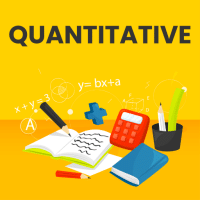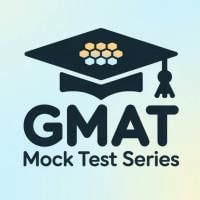GMAT Exam > GMAT Questions > The operation denoted by the symbol # is defi...
Start Learning for Free
The operation denoted by the symbol # is defined for all real numbers p and r as p#r equals the larger of p and r. For example, 5#3 = 5. Which one of the distinct numbers x, y and z is the largest?
(1) (x#y)#z = x#z
(2) (x#z)#y = z#y
(1) (x#y)#z = x#z
(2) (x#z)#y = z#y
- a)Statement (1) ALONE is sufficient, but statement (2) alone is not sufficient to answer the question asked.
- b)Statement (2) ALONE is sufficient, but statement (1) alone is not sufficient to answer the question asked.
- c)BOTH statements (1) and (2) TOGETHER are sufficient to answer the question asked, but NEITHER statement ALONE is sufficient to answer the question ask
- d)EACH statement ALONE is sufficient to answer the question asked.
- e)Statements (1) and (2) TOGETHER are NOT sufficient to answer the question asked, and additional data specific to the problem are needed.
Correct answer is option 'C'. Can you explain this answer?
Most Upvoted Answer
The operation denoted by the symbol # is defined for all real numbers ...
(1) When X and Y are together: X turns out to be greater than Y, hence we get to see X#Z on the RHS so X>Y but no information on relation of X and Z - INSUFFICIENT
(2) When X and Z are together: Z turns out to be greater than X, hence we get to see Z#Y on the RHS so Z>X but no information on relation of Z and Y - INSUFFICIENT
Considering both - So X>Y and Z>X hence the relation is Z>X>Y
(2) When X and Z are together: Z turns out to be greater than X, hence we get to see Z#Y on the RHS so Z>X but no information on relation of Z and Y - INSUFFICIENT
Considering both - So X>Y and Z>X hence the relation is Z>X>Y

|
Explore Courses for GMAT exam
|

|
Question Description
The operation denoted by the symbol # is defined for all real numbers p and r as p#r equals the larger of p and r. For example, 5#3 = 5. Which one of the distinct numbers x, y and z is the largest?(1) (x#y)#z = x#z(2) (x#z)#y = z#ya)Statement (1) ALONE is sufficient, but statement (2) alone is not sufficient to answer the question asked.b)Statement (2) ALONE is sufficient, but statement (1) alone is not sufficient to answer the question asked.c)BOTH statements (1) and (2) TOGETHER are sufficient to answer the question asked, but NEITHER statement ALONE is sufficient to answer the question askd)EACH statement ALONE is sufficient to answer the question asked.e)Statements (1) and (2) TOGETHER are NOT sufficient to answer the question asked, and additional data specific to the problem are needed.Correct answer is option 'C'. Can you explain this answer? for GMAT 2025 is part of GMAT preparation. The Question and answers have been prepared according to the GMAT exam syllabus. Information about The operation denoted by the symbol # is defined for all real numbers p and r as p#r equals the larger of p and r. For example, 5#3 = 5. Which one of the distinct numbers x, y and z is the largest?(1) (x#y)#z = x#z(2) (x#z)#y = z#ya)Statement (1) ALONE is sufficient, but statement (2) alone is not sufficient to answer the question asked.b)Statement (2) ALONE is sufficient, but statement (1) alone is not sufficient to answer the question asked.c)BOTH statements (1) and (2) TOGETHER are sufficient to answer the question asked, but NEITHER statement ALONE is sufficient to answer the question askd)EACH statement ALONE is sufficient to answer the question asked.e)Statements (1) and (2) TOGETHER are NOT sufficient to answer the question asked, and additional data specific to the problem are needed.Correct answer is option 'C'. Can you explain this answer? covers all topics & solutions for GMAT 2025 Exam. Find important definitions, questions, meanings, examples, exercises and tests below for The operation denoted by the symbol # is defined for all real numbers p and r as p#r equals the larger of p and r. For example, 5#3 = 5. Which one of the distinct numbers x, y and z is the largest?(1) (x#y)#z = x#z(2) (x#z)#y = z#ya)Statement (1) ALONE is sufficient, but statement (2) alone is not sufficient to answer the question asked.b)Statement (2) ALONE is sufficient, but statement (1) alone is not sufficient to answer the question asked.c)BOTH statements (1) and (2) TOGETHER are sufficient to answer the question asked, but NEITHER statement ALONE is sufficient to answer the question askd)EACH statement ALONE is sufficient to answer the question asked.e)Statements (1) and (2) TOGETHER are NOT sufficient to answer the question asked, and additional data specific to the problem are needed.Correct answer is option 'C'. Can you explain this answer?.
The operation denoted by the symbol # is defined for all real numbers p and r as p#r equals the larger of p and r. For example, 5#3 = 5. Which one of the distinct numbers x, y and z is the largest?(1) (x#y)#z = x#z(2) (x#z)#y = z#ya)Statement (1) ALONE is sufficient, but statement (2) alone is not sufficient to answer the question asked.b)Statement (2) ALONE is sufficient, but statement (1) alone is not sufficient to answer the question asked.c)BOTH statements (1) and (2) TOGETHER are sufficient to answer the question asked, but NEITHER statement ALONE is sufficient to answer the question askd)EACH statement ALONE is sufficient to answer the question asked.e)Statements (1) and (2) TOGETHER are NOT sufficient to answer the question asked, and additional data specific to the problem are needed.Correct answer is option 'C'. Can you explain this answer? for GMAT 2025 is part of GMAT preparation. The Question and answers have been prepared according to the GMAT exam syllabus. Information about The operation denoted by the symbol # is defined for all real numbers p and r as p#r equals the larger of p and r. For example, 5#3 = 5. Which one of the distinct numbers x, y and z is the largest?(1) (x#y)#z = x#z(2) (x#z)#y = z#ya)Statement (1) ALONE is sufficient, but statement (2) alone is not sufficient to answer the question asked.b)Statement (2) ALONE is sufficient, but statement (1) alone is not sufficient to answer the question asked.c)BOTH statements (1) and (2) TOGETHER are sufficient to answer the question asked, but NEITHER statement ALONE is sufficient to answer the question askd)EACH statement ALONE is sufficient to answer the question asked.e)Statements (1) and (2) TOGETHER are NOT sufficient to answer the question asked, and additional data specific to the problem are needed.Correct answer is option 'C'. Can you explain this answer? covers all topics & solutions for GMAT 2025 Exam. Find important definitions, questions, meanings, examples, exercises and tests below for The operation denoted by the symbol # is defined for all real numbers p and r as p#r equals the larger of p and r. For example, 5#3 = 5. Which one of the distinct numbers x, y and z is the largest?(1) (x#y)#z = x#z(2) (x#z)#y = z#ya)Statement (1) ALONE is sufficient, but statement (2) alone is not sufficient to answer the question asked.b)Statement (2) ALONE is sufficient, but statement (1) alone is not sufficient to answer the question asked.c)BOTH statements (1) and (2) TOGETHER are sufficient to answer the question asked, but NEITHER statement ALONE is sufficient to answer the question askd)EACH statement ALONE is sufficient to answer the question asked.e)Statements (1) and (2) TOGETHER are NOT sufficient to answer the question asked, and additional data specific to the problem are needed.Correct answer is option 'C'. Can you explain this answer?.
Solutions for The operation denoted by the symbol # is defined for all real numbers p and r as p#r equals the larger of p and r. For example, 5#3 = 5. Which one of the distinct numbers x, y and z is the largest?(1) (x#y)#z = x#z(2) (x#z)#y = z#ya)Statement (1) ALONE is sufficient, but statement (2) alone is not sufficient to answer the question asked.b)Statement (2) ALONE is sufficient, but statement (1) alone is not sufficient to answer the question asked.c)BOTH statements (1) and (2) TOGETHER are sufficient to answer the question asked, but NEITHER statement ALONE is sufficient to answer the question askd)EACH statement ALONE is sufficient to answer the question asked.e)Statements (1) and (2) TOGETHER are NOT sufficient to answer the question asked, and additional data specific to the problem are needed.Correct answer is option 'C'. Can you explain this answer? in English & in Hindi are available as part of our courses for GMAT.
Download more important topics, notes, lectures and mock test series for GMAT Exam by signing up for free.
Here you can find the meaning of The operation denoted by the symbol # is defined for all real numbers p and r as p#r equals the larger of p and r. For example, 5#3 = 5. Which one of the distinct numbers x, y and z is the largest?(1) (x#y)#z = x#z(2) (x#z)#y = z#ya)Statement (1) ALONE is sufficient, but statement (2) alone is not sufficient to answer the question asked.b)Statement (2) ALONE is sufficient, but statement (1) alone is not sufficient to answer the question asked.c)BOTH statements (1) and (2) TOGETHER are sufficient to answer the question asked, but NEITHER statement ALONE is sufficient to answer the question askd)EACH statement ALONE is sufficient to answer the question asked.e)Statements (1) and (2) TOGETHER are NOT sufficient to answer the question asked, and additional data specific to the problem are needed.Correct answer is option 'C'. Can you explain this answer? defined & explained in the simplest way possible. Besides giving the explanation of
The operation denoted by the symbol # is defined for all real numbers p and r as p#r equals the larger of p and r. For example, 5#3 = 5. Which one of the distinct numbers x, y and z is the largest?(1) (x#y)#z = x#z(2) (x#z)#y = z#ya)Statement (1) ALONE is sufficient, but statement (2) alone is not sufficient to answer the question asked.b)Statement (2) ALONE is sufficient, but statement (1) alone is not sufficient to answer the question asked.c)BOTH statements (1) and (2) TOGETHER are sufficient to answer the question asked, but NEITHER statement ALONE is sufficient to answer the question askd)EACH statement ALONE is sufficient to answer the question asked.e)Statements (1) and (2) TOGETHER are NOT sufficient to answer the question asked, and additional data specific to the problem are needed.Correct answer is option 'C'. Can you explain this answer?, a detailed solution for The operation denoted by the symbol # is defined for all real numbers p and r as p#r equals the larger of p and r. For example, 5#3 = 5. Which one of the distinct numbers x, y and z is the largest?(1) (x#y)#z = x#z(2) (x#z)#y = z#ya)Statement (1) ALONE is sufficient, but statement (2) alone is not sufficient to answer the question asked.b)Statement (2) ALONE is sufficient, but statement (1) alone is not sufficient to answer the question asked.c)BOTH statements (1) and (2) TOGETHER are sufficient to answer the question asked, but NEITHER statement ALONE is sufficient to answer the question askd)EACH statement ALONE is sufficient to answer the question asked.e)Statements (1) and (2) TOGETHER are NOT sufficient to answer the question asked, and additional data specific to the problem are needed.Correct answer is option 'C'. Can you explain this answer? has been provided alongside types of The operation denoted by the symbol # is defined for all real numbers p and r as p#r equals the larger of p and r. For example, 5#3 = 5. Which one of the distinct numbers x, y and z is the largest?(1) (x#y)#z = x#z(2) (x#z)#y = z#ya)Statement (1) ALONE is sufficient, but statement (2) alone is not sufficient to answer the question asked.b)Statement (2) ALONE is sufficient, but statement (1) alone is not sufficient to answer the question asked.c)BOTH statements (1) and (2) TOGETHER are sufficient to answer the question asked, but NEITHER statement ALONE is sufficient to answer the question askd)EACH statement ALONE is sufficient to answer the question asked.e)Statements (1) and (2) TOGETHER are NOT sufficient to answer the question asked, and additional data specific to the problem are needed.Correct answer is option 'C'. Can you explain this answer? theory, EduRev gives you an
ample number of questions to practice The operation denoted by the symbol # is defined for all real numbers p and r as p#r equals the larger of p and r. For example, 5#3 = 5. Which one of the distinct numbers x, y and z is the largest?(1) (x#y)#z = x#z(2) (x#z)#y = z#ya)Statement (1) ALONE is sufficient, but statement (2) alone is not sufficient to answer the question asked.b)Statement (2) ALONE is sufficient, but statement (1) alone is not sufficient to answer the question asked.c)BOTH statements (1) and (2) TOGETHER are sufficient to answer the question asked, but NEITHER statement ALONE is sufficient to answer the question askd)EACH statement ALONE is sufficient to answer the question asked.e)Statements (1) and (2) TOGETHER are NOT sufficient to answer the question asked, and additional data specific to the problem are needed.Correct answer is option 'C'. Can you explain this answer? tests, examples and also practice GMAT tests.

|
Explore Courses for GMAT exam
|

|
Signup for Free!
Signup to see your scores go up within 7 days! Learn & Practice with 1000+ FREE Notes, Videos & Tests.


















